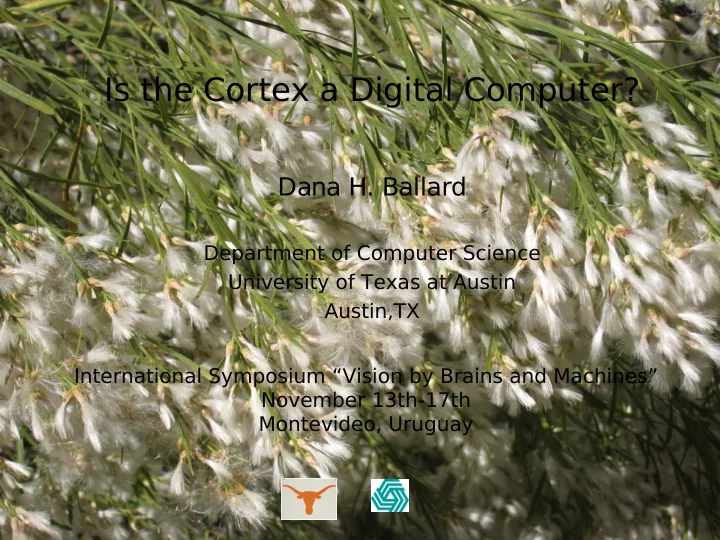

Is the Cortex a Digital Computer? Dana H. Ballard Department of Computer Science University of Texas at Austin Austin,TX International Symposium “Vision by Brains and Machines” November 13th-17th Montevideo, Uruguay
Computational Hierarchy Function Description OS Choose procedural set Action Select the next thing to do within a procedure State Estimate state Calibration Create baseline calibrations
Visual Routines Roelfsema et al PNAS 2003
See Neuron 1999 Special Issue Multi-tasking As Revealed by Gaze Sharing in Human Data Mid-Block 40m Stop sign Car Mid-block sign 60 Intersection sign 50 40 Eye 30 20 10 0 0 5 10 15 3 3 3 3 172 10 177 10 182 10 187 10 time(sec) Shinoda and Hayhoe, Vision Research 2001
QuickTime and a YUV420 codec decompressor are needed to see this picture.
Temporal Rate Coding milliseconds
Why Rate Coding cannot work
Why Rate Coding cannot work
NN Hebb rule: Maximize XW Want x ~ ∆ T ~ ∆ W
In a rate coding model, the position of the spike at a synapse wrt the output spike must be random
Timing Synaptic weight Poisson Updates
Poisson Timing Synaptic weight Updates
A small ~ 1-2 ms delay can be used to signal an analog quantity reference δ 1 ms
A Rank Order Code VanRullen & Thorpe Vision Res 2002
Feedback Spike Timing Constraint + _ r Loop delay = 20 milliseconds
Computational Hierarchy Function Description OS Choose procedural set Action Select the next thing to do within a procedure State Estimate state Calibration Create baseline calibrations
LGN-V1 Circuit e = I - U r T U r est I r + LGN - Cortex U
A Slice Through The Cortex r r r + + + - - - LGN V1 V2
from Usrey & Reid
Labeled Line Math
x u β Case 2 NN vol8 p1552
Comparing the Model to Data Model Experiment
Computational Hierarchy Function Description OS Choose procedural set Action Select the next thing to do within a procedure State Estimate state Calibration Create baseline calibrations
See also: Computing With Self-Excitatory Cliques: A Model and an Application to Hyperacuity-Scale... Zucker and Miller, Neural Comp..1999; 11: 21-66
Lund & Bressloff (2003) Cerebral Cortex 14 500 µ
Reasons for copies Copies exist in columns _ Copies provide robustness to _ cell death Copies allow mathematical _ exploration Copies allow multiprocessing _ Circumvent refractory period _
What would the spikes look like in such a scheme?
Parameters Trials ~ No. of individual experimental trials Processes ~ No. of ongoing procedures Copies ~ No. of cells with same RF Duration ~ Duration of an individual trial Jitter ~ Displacement used to signal analog value* * Not used
Trials =50 Processes = 2 Copies = 6 Duration =1 sec m Distributed Synchrony Simulation σ
Poisson Process m σ
Raj Rao Zuohua Zhang Johnathan Shaw Constantin Rothkopf Janneke Jehee
Computation Neuroscience Physics
Axonal Propagation Speeds: Evidence? 2-6 cm/s 0.1 - 0.4 cm/s
Code input I with synapses U and output r Min E(U,r) = |I-Ur| 2 + F(r) + G(U) U,r Coding cost of Coding Cost of model residual error [Olshausen and Field 1997]
Synapses are Trained with Natural Images Min E(U, r ) = |I-U r | 2 + F( r ) + G(U) 1. Apply Image Dr µ- ¶ E 2. Change firing ¶ r DU µ- ¶ E 3. Change Synapses ¶ U
Handling the Error Term with r I + - U Predictive Coding LGN Cortex r 1 I r 2 I = u 1 r 1 u 2 r 2 ... u m r m
Sparse Priors are Biological
A Slice Through The Cortex r r r + + + - - X - LGN V1 V2
Endstopping RF Rao and Ballard, Nature Neuroscience 1999
Drawbacks of rate coding Inherent inaccuracy with signaling with a _ probabilistic code Averaging over populations is expensive _ Unary codes are inefficient _ Its never used in simulations _ Decoders are of marginal utility _ Ubiquitous observation of Poisson _ statistics Rate coding is incompatible with the Hebb _ Rule (Bi & Poo)
Retina LGN M. Meister et al C. Reid et al
Recommend
More recommend